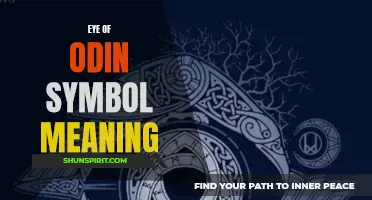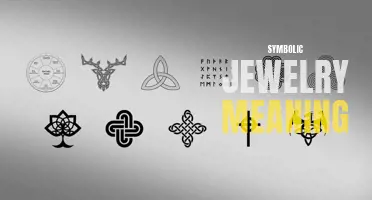
The Egyptian cross symbol, also known as the Ankh, has been a fascinating and enigmatic emblem throughout history. It holds deep meaning and significance in Egyptian mythology and culture. From representing the key to life and immortality to symbolizing fertility and the power of the gods, the Egyptian cross has captivated minds and sparked curiosity for centuries. Join us on a journey through time as we explore the mesmerizing and mysterious meanings behind this ancient symbol.
What You'll Learn
- What is the historical significance of the Egyptian cross symbol?
- How is the Egyptian cross symbol interpreted in modern contexts?
- What are some common misconceptions about the meaning of the Egyptian cross symbol?
- How does the Egyptian cross symbol differ from the Christian cross?
- Are there any specific rituals or practices associated with the Egyptian cross symbol?

What is the historical significance of the Egyptian cross symbol?
The Egyptian cross, also known as the Ankh or the Key of Life, is a symbol that holds significant historical and cultural importance in ancient Egypt. Its design consists of a loop with a cross-like structure at the top, resembling a key. The Ankh was widely used by the ancient Egyptians and can be seen in various forms of art and architecture throughout their civilization.
The Ankh is believed to have originated during the Early Dynastic Period of ancient Egypt (c. 3100–2686 BCE) and continued to be used until the end of the Ptolemaic Period (332 BCE–30 BCE). It is closely associated with the religious beliefs and practices of the Egyptians, specifically their obsession with life, death, rebirth, and the afterlife.
One of the main reasons the Egyptian cross holds such historical significance is its perceived connection with eternal life and the concept of immortality. The loop at the top of the symbol is believed to represent the eternal spirit or soul, while the cross at the bottom represents the physical body. The Ankh, therefore, serves as a powerful symbol of the union between the material and spiritual realms.
In ancient Egyptian art, the Ankh is often depicted being held by gods and pharaohs, emphasizing their divine status and eternal existence. It was believed that by possessing or wearing the Ankh, one could obtain divine protection and guidance. The symbol was commonly incorporated into amulets, tombs, and other religious objects to ensure the well-being and spiritual journey of the deceased.
Furthermore, the Ankh is closely associated with the goddess Isis, who was one of the most prominent and revered deities in the Egyptian pantheon. Isis was often depicted holding the Ankh, symbolizing her role as the giver of life and protector of the deceased. The Ankh also became a symbol of fertility and was associated with the life-giving powers of the Nile River.
The Ankh's influence extends beyond the borders of ancient Egypt. In later periods, such as the Hellenistic and Roman eras, it was adopted by various cultures and incorporated into their own religious and artistic traditions. For example, the Ankh is often seen in the hands of deities in ancient Nubian art.
Today, the Egyptian cross continues to be a popular symbol, both in its original form and as a modern adaptation. Its depiction can be found on various objects, such as jewelry, tattoos, and clothing, often used as a representation of life, spirituality, and protection.
In conclusion, the Egyptian cross symbol, or Ankh, holds significant historical importance in ancient Egyptian culture. It represents the eternal union between the physical and spiritual realms, and its association with life, death, and the afterlife makes it a powerful and enduring symbol in Egyptian art, religion, and mythology. The Ankh's influence has transcended time and continues to be recognized and appreciated in modern times.
The Rich Symbolism and Deep Meanings Behind Celtic Jewelry
You may want to see also

How is the Egyptian cross symbol interpreted in modern contexts?
The Egyptian Cross, also known as the Ankh, is a symbol that has been used for thousands of years in ancient Egyptian culture. It represents the concept of life and immortality, and its shape resembles a cross with a loop at the top. In modern contexts, the Egyptian Cross is often interpreted in various ways, depending on the cultural and spiritual beliefs of individuals and communities.
One of the most common interpretations of the Egyptian Cross is as a symbol of eternal life or the afterlife. This belief stems from the ancient Egyptian belief in the concept of the soul, which was thought to continue its existence even after death. The Ankh was often used in burial ceremonies and depicted in tombs as a representation of the deceased's journey into the afterlife. In this context, the Egyptian Cross is seen as a symbol of hope, resurrection, and the continuation of the soul's journey.
In addition to its association with the afterlife, the Egyptian Cross is also interpreted as a symbol of fertility and sexual union. The loop at the top of the Ankh is often seen as a representation of the womb, while the vertical line represents the masculine force. This interpretation highlights the importance of balance and harmony between masculine and feminine energies in order to create life and ensure the continuation of the human race.
Furthermore, the Egyptian Cross is sometimes interpreted as a symbol of the divine and the connection between humans and the gods. In ancient Egyptian mythology, the Ankh was often associated with the gods and goddesses, particularly those associated with life and creation. In modern spiritual practices, the Egyptian Cross is sometimes used as a talisman or amulet to symbolize divine protection, guidance, and spiritual power.
In recent years, the Egyptian Cross has also gained popularity as a fashion statement and a symbol of cultural appreciation. Many people wear jewelry or clothing adorned with the Ankh as a way to connect with ancient Egyptian culture and express their interest in spirituality and symbolism. However, it is important to note that some interpretations of the Egyptian Cross may be considered cultural appropriation, so it is essential to educate oneself about the meaning and significance of the symbol before using it for personal purposes.
In conclusion, the Egyptian Cross, or Ankh, is a symbol that holds multiple interpretations in modern contexts. It can be seen as a representation of eternal life, fertility, divine connection, and cultural appreciation. While the meaning of the Egyptian Cross may vary from person to person, its power as a symbol of life and spirituality remains a constant throughout human history.
Unveiling the Hidden Meanings Behind Roman Symbols and Their Significance
You may want to see also

What are some common misconceptions about the meaning of the Egyptian cross symbol?
The Egyptian cross symbol, known as the Ankh, is one of the most recognizable symbols from ancient Egypt. It is often seen in depictions of gods and goddesses as well as in hieroglyphs and other forms of ancient Egyptian art. Despite its prominence, there are several common misconceptions about the meaning of the Ankh.
One common misconception is that the Ankh is a religious symbol representing the Christian concept of the crucifixion. This is incorrect as the Ankh predates Christianity by thousands of years. It was used in ancient Egypt as a symbol of life and fertility. The loop at the top of the Ankh represents the sun rising above the horizon and therefore symbolizes life and vitality. The cross shape represents the earthly realm and the union of male and female energies.
Another misconception is that the Ankh is a symbol of death or the afterlife. This misconception may arise from the fact that the Ankh is often seen in depictions of deities associated with the afterlife, such as Osiris and Isis. However, the Ankh itself is not a symbol of death but rather a symbol of life and the continuation of life beyond death. It was often depicted being held by the gods and goddesses, showing their ability to grant or sustain life.
The Ankh is sometimes mistaken for a symbol of male and female fertility or sexual union. While it is true that the Ankh represents the union of male and female energies, it is not solely a symbol of sexual union or fertility. It is a much broader symbol of the life force and the perpetuation of life in all its forms.
One more common misconception is that the Ankh was exclusively used by the elite or the ruling class in ancient Egypt. While it is true that the Ankh was often depicted in the hands of gods and pharaohs, it was not limited to the elite. The Ankh was a symbol that was widely recognized and used by people of all social classes in ancient Egypt. It was seen as a symbol of life and vitality and was believed to bring good luck and protection.
In conclusion, the Egyptian cross symbol, or Ankh, has several misconceptions surrounding its meaning. It is not a religious symbol representing the crucifixion, but rather a symbol of life and fertility. It is not a symbol of death or the afterlife, but rather a symbol of the continuation of life. It is not solely a symbol of sexual union or fertility, but rather a symbol of the life force in all its forms. And finally, it was not exclusively used by the elite, but rather by people of all social classes in ancient Egypt.
Unlocking the Mysteries: Understanding the Meanings of Protection Symbols
You may want to see also

How does the Egyptian cross symbol differ from the Christian cross?
The Egyptian cross symbol, also known as the Ankh, and the Christian cross are two distinct symbols with different origins and meanings. While both symbols have a similar cross shape, they represent different cultures, religions, and beliefs.
The Ankh, also known as the key of life, is one of the most recognizable Egyptian symbols. It has a distinct loop at the top and is often depicted being held by Egyptian deities. The origins of the Ankh date back to ancient Egypt, where it symbolized life and fertility. The loop at the top of the cross represents the sun or the eternal nature of life, while the vertical line represents the physical realm. The Ankh was often associated with the gods and goddesses of ancient Egypt, as it was believed to hold the key to eternal life and an afterlife. It can also be seen in depictions of pharaohs and other Egyptian figures, emphasizing their connection to the divine and their eternal reign.
On the other hand, the Christian cross is the central symbol of Christianity and represents the crucifixion of Jesus Christ. It consists of a vertical line intersected by a shorter horizontal line near the top. The Christian cross has deep religious significance for Christians, as it reminds them of Jesus' sacrifice and redemption. The symbol serves as a constant reminder of the core beliefs and teachings of Christianity, including love, forgiveness, and salvation through faith in Jesus Christ. The Christian cross is seen as a symbol of hope and a way to unite believers under a common faith.
In terms of symbolism, the Egyptian cross and the Christian cross have different meanings and contexts. The Ankh represents life, immortality, and the divine, while the Christian cross represents sacrifice, redemption, and the pursuit of spiritual salvation. The Ankh is deeply rooted in ancient Egyptian mythology, whereas the Christian cross is a central symbol of Christianity and its teachings.
Furthermore, the Ankh and the Christian cross differ in their cultural and religious associations. The Ankh is specifically associated with ancient Egyptian culture and belief systems, while the Christian cross is a widely recognized symbol of Christianity that is embraced by followers around the world. The Ankh holds a prominent place in ancient Egyptian art, religious rituals, and tomb decorations, while the Christian cross is present in churches, homes, and various Christian ceremonies.
In conclusion, the Egyptian cross symbol, known as the Ankh, and the Christian cross are two distinct symbols with different origins and meanings. The Ankh represents life and divinity in ancient Egyptian culture, while the Christian cross symbolizes the sacrifice and redemption of Jesus Christ in Christianity. These symbols hold deep cultural, religious, and historical significance for their respective cultures and beliefs.
Exploring the Secret Language of Fraternity Symbol Meanings
You may want to see also

Are there any specific rituals or practices associated with the Egyptian cross symbol?
The Egyptian cross symbol, also known as the ankh, is a powerful symbol that has been associated with various rituals and practices in ancient Egyptian culture. The ankh is shaped like a cross, with a loop at the top instead of a straight line. It is often depicted being held by gods and goddesses in ancient Egyptian art, signifying their power and authority.
One of the most widely recognized symbols in ancient Egypt, the ankh was believed to represent the key to life. It was believed to hold the power to unlock the mysteries of life and death, and was often associated with fertility and rebirth. Due to its association with life and vitality, the ankh was often used in rituals related to healing and protection.
In ancient Egyptian rituals, the ankh was often used as a symbol of blessing and protection. It was believed to have the power to ward off evil spirits and provide protection to those who wore or carried it. It was common for individuals to wear an ankh amulet or pendant, as a way to ensure their safety and well-being.
The ankh was also used in rituals related to funerals and the afterlife. It was often depicted in tombs and on funerary objects, symbolizing the key to the afterlife. It was believed that by including the ankh in burial rituals, the deceased would have a smooth transition to the next life and be granted eternal life.
Additionally, the ankh was believed to have a protective and purifying effect in rituals involving the gods and goddesses. It was often used as a tool for cleansing and purifying the sacred spaces where rituals were performed. The ankh was sometimes dipped in water or incense smoke and then waved over the offerings or participants to bless and protect them.
In modern times, the ankh continues to be a popular symbol with various meanings attached to it. It is often used as a symbol of life, vitality, and spiritual awakening. Many people wear ankh jewelry or incorporate the symbol into their tattoos as a way to connect with the ancient Egyptian culture and its rich spiritual heritage.
In conclusion, the Egyptian cross symbol, or ankh, was associated with various rituals and practices in ancient Egyptian culture. It was used in rituals related to healing, protection, funerals, and the afterlife. The ankh's association with life and vitality made it a powerful symbol, believed to hold the key to unlocking the mysteries of life and death. Today, the ankh continues to be a meaningful symbol for many, representing life, spirituality, and connection to ancient Egyptian culture.
Decoding the Volvo Dashboard Symbols: What Do They Really Mean?
You may want to see also
Frequently asked questions
The Egyptian cross symbol, also known as the Ankh, represents the concept of eternal life. It was a symbol of life and fertility in ancient Egypt, often associated with the gods and goddesses of the afterlife.
Yes, the Ankh was a powerful religious symbol in ancient Egypt. It was often seen in the hands of gods and goddesses, symbolizing their ability to grant eternal life to believers. It was commonly used in religious ceremonies and depicted in ancient Egyptian art.
The Ankh was often used in everyday life in ancient Egypt. It was seen as a protective amulet and was frequently worn as jewelry. It was also placed in tombs to ensure the deceased had a successful journey into the afterlife.
Yes, the Ankh is still recognized and utilized as a symbol today. It has been adopted by various modern cultures and is often used as a fashion statement or as a symbol of spirituality and mysticism.
In addition to its connection to eternal life, the Ankh is also associated with health, wealth, and prosperity. It is believed to have protective abilities and is often associated with good luck. It is a powerful symbol that continues to hold significance in various cultures around the world.







